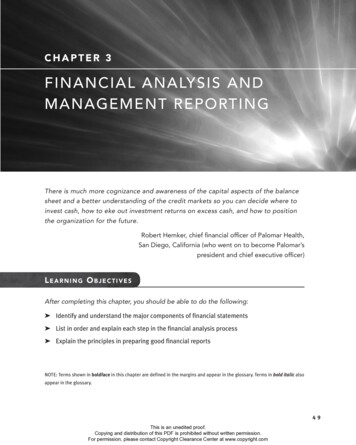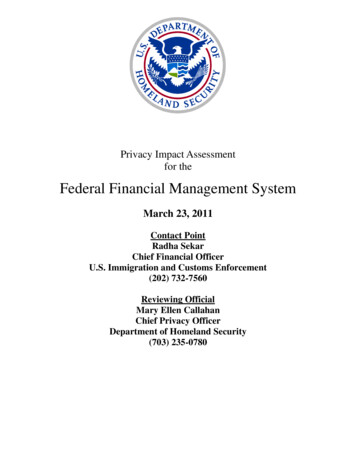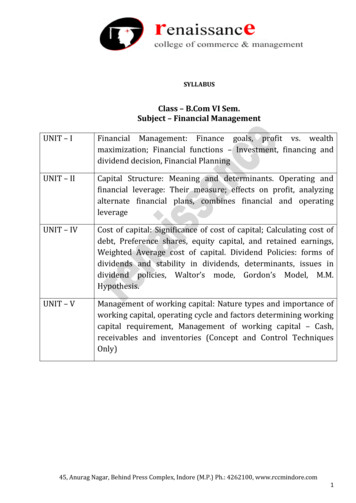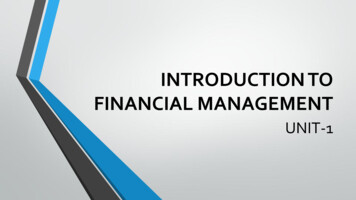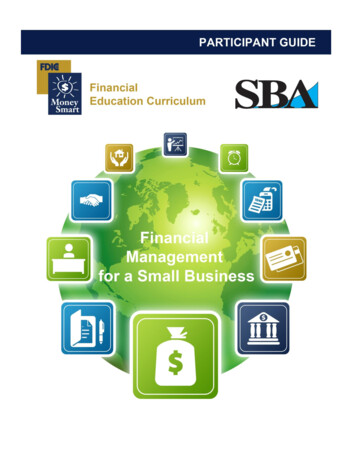
Transcription
Financial Management11thEdition
Financial Management11thEditionI M PandeyDirector GeneralDelhi School of BuSineSSanDViVekananD inStitute ofProfeSSional StuDieSnew DelhiFormer ProFessor & DeaniiM, ahMeDaBaDVIKAS PUBLISHING HOUSE PVT LTD
VIKAS PUBLISHING HOUSE PVT LTDE-28, Sector-8, Noida-201301 (UP) IndiaPhone: 91-120-4078900 Fax: 91-120-4078999Registered Office: 576, Masjid Road, Jangpura, New Delhi-110014. IndiaE-mail: helpline@vikaspublishing.com Website: www.vikaspublishing.com Ahmedabad : 305, Grand Monarch, 100 ft Shyamal Road, Near Seema Hall,Ahmedabad-380051 Ph. 91-79-65254204 Bengaluru : First Floor, N S Bhawan, 4th Cross, 4th Main, Gandhi Nagar,Bengaluru-560009 Ph. 91-80-22281254, 22204639 Chennai: E-12, Nelson Chambers, 115, Nelson Manickam Road, Aminjikarai,Chennai-600029 Ph. 91-44-23744547, 23746090 Hyderabad : Aashray Mansion, Flat-G (G.F.), 3-6-361/8, Street No. 20, Himayath Nagar, Hyderabad-500029 Ph. 91-40-23269992 Fax. 91-40-23269993 Kolkata: 6B, Rameshwar Shaw Road, Kolkata-700014 Ph. 91-33-22897888 Mumbai: 67/68, 3rd Floor, Aditya Industrial Estate, Chincholi Bunder,BehindBalaji International School & Evershine Mall, Malad (West),Mumbai-400064 Ph. 91-22-28772545, 28768301 Patna: Flat No. 101, Sri Ram Tower, Beside Chiraiyatand Over Bridge,Kankarbagh Main Rd., Kankarbagh, Patna-800020 Ph. 91-612-2351147Financial ManagementISBN: 978-93259-8229-1Eleventh Edition 2015Vikas is the registered trademark of Vikas Publishing House Pvt LtdCopyright I M Pandey, 1976, 2010, 2015All rights reserved. No part of this publication which is material protected by this copyright notice may be reproduced or transmitted or utilized or storedin any form or by any means now known or hereinafter invented, electronic, digital or mechanical, including photocopying, scanning, recording or by anyinformation storage or retrieval system, without prior written permission from the publisher.Information contained in this book has been published by VIKAS Publishing House Pvt Ltd and has been obtained by its Authors from sources believedto be reliable and are correct to the best of their knowledge. However, the Publisher and its Authors shall in no event be liable for any errors, omissions ordamages arising out of use of this information and specifically disclaim any implied warranties or merchantability or fitness for any particular use. Disputesif any are subject to Delhi Jurisdiction only.Printed in India.
PrefaceAbout three decades ago, the scope of financial management was confined to raising of funds, and less significancewas attached to analytical thinking in financial decision-making and problem solving. As a consequence, the earliertextbooks on finance were structured around this theme and contained descriptions of the instruments and institutionsof raising funds and of the major events, like promotion, reorganization, readjustment, merger, consolidation, etc.,when funds were raised. In the mid-fifties, the emphasis shifted to judicious utilization of funds. Modern thinking infinancial management accords a far greater importance to management decision-making and policy. Today, financialmanagers do not perform the passive role of scorekeepers of financial data and information, and arranging funds,whenever directed to do so. Rather, they occupy key positions in top management areas and play a dynamic role insolving complex management problems. They are now responsible for shaping the fortunes of the enterprise and areinvolved in the most vital management decision of allocation of capital. It is their duty to ensure that the funds areraised most economically and used in the most efficient and effective manner. Because of this change in emphasis,the descriptive treatment of the subject of financial management is being replaced by growing analytical content andsound theoretical underpinnings. This is the approach adopted in this book.Focus of the BookI wrote the first edition of Financial Management in 1978 with the following objectives, which remain unchanged inthe eleventh edition of the book:1. To demonstrate to readers that the subject of finance is simple to understand, relevant in practice and interestingto learn.2. To help readers appreciate the logic for making better financial decisions.3. To explain the concepts and theories of finance in a simple way so readers can grasp them very easily and areable to put them into practice.4. To provide a book that has a comprehensive coverage for MBA and other postgraduate courses.5. To create a book that differentiates itself from other textbooks in terms of coverage, presentation, and with anequal focus on theory and practice, with real-life examples.Financial Management combines theory with practical applications. It begins with the discussion of fundamentalconcepts of value and return, risk and return relationship and valuation of shares and bonds. With this foundation,readers can easily understand the theories and methods, decision criteria, and financial policies and strategies necessaryto manage funds and create and enhance the value of the firm.Financial Management in its eleventh edition, like in its previous editions, highlights the ‘modern’, analyticalapproach to corporate finance decision-making. The text material has been structured to focus on finance theoryand its implications in the financial decision-making process and policy. The book discusses the theories, concepts,assumptions, and the mechanics underlying financial decisions, viz., investment, financing, dividend, and workingcapital management. It also discusses sources and instruments of short-term and long-term finances, mergers andacquisitions, international financial management and the interface between financial and corporate policies. Importantly,the book helps students to relate theories and concepts to practice.Features of the BookFinancial Management aims to assist the reader to develop a thorough understanding of the concepts and theoriesunderlying financial management in a systematic way. To accomplish this purpose, the recent thinking in the field offinance has been presented in a most lucid, simple, unambiguous and precise manner.
viii PrefaceThe book contains a comprehensive treatment of topics on valuation, risk and return, options, capital budgeting,capital structure, dividend decisions, working capital management, mergers and acquisitions, shareholder value,corporate governance and international financial management with a view that readers understand these financialdecisions thoroughly and are able to evaluate their implications for the shareholders and the company. The financialanalysis, planning and modelling techniques are also discussed in detail for the benefit of those readers who have notbeen exposed to these topics earlier.The book stresses the analytical approach for solving financial problems. Concepts are made clear in simple languagebefore introducing complicated and sophisticated techniques and theories. For a better and easy comprehension ofthe concepts and theories, the book contains a number of real-life financial problems and cases in the Indian contextin addition to examples and illustrative problems. Each chapter contains a summary of the key points as well as alist of key concepts. At the end of each chapter, review questions, quizzes and problems have been added, a numberof which are based on professional courses and examinations. Review questions can be used for discussions in theclass by teachers. Problems have been included to help readers apply the concepts discussed in the chapter. Thesehave been designed to illustrate the key points in the text. Some questions and problems require readers to evaluate asituation or critically examine and analyse it. A special feature of Financial Management is the real-life cases of Indiancompanies at the end of most chapters. It is hoped that this will facilitate a better understanding of the subject matterand its practical application.Many chapters of Financial Management, Eleventh Edition, have been revised. New concepts, like consumption beta,simulation in capital budgeting, three factor model, etc., have been added. A number of new real-life examples ofcompanies have been included. Readers may notice that some real-life cases and other materials have been providedin Exhibits (boxes) to draw their attention. These have also been identified in the Contents. Particular care has beentaken to ensure the correctness of equations, formulae, solved problems, and illustrations.The main features of the book are as follows:1. Excel applications Proficiency with spreadsheets and Excel is a great advantage to financial analysts andmanagers and a necessity for all the postgraduate students of management, commerce and accounting courses.With this in mind, at appropriate places, Excel Applications have been created showing how spreadsheets withthe help of Excel could be used to solve finance problems and take decisions. These have also been identifiedin the Contents.2. Web links for financial data Students must know how to access financial data and information on the Internet.With this in mind, a list of useful web links has been created to help readers retrieve useful financial information.3. Illustrative problems Finance decisions involve solving problems using theoretical concepts. The book containssolved illustrations showing readers how concepts could be used to solve problems and take decisions.4. Real-life examples The book contains a large number of real-life cases and examples to illustrate the practicalapplications of finance theories and concepts.5. Cases Most chapters include mini cases that reflect the applications of the conceptual material in the chapters.6. Key concepts For the benefit of readers, the key concepts of each chapter have been listed at the end of thechapter.7. Practical project Most chapters have a ‘Practical Project’ each where students are helped to apply theirknowledge to real company situations.Beta calculation in practice Over the past few years, the use of beta in decision-making has increased in India.The National Stock Exchange (www.nse-india.com) gives beta based on daily share prices for a one-year period fora number of companies. This information may not be useful when we require beta based on a longer time period orfor different time periods. Chapter 6 shows how beta can be calculated for a real company in practice. Thus, use of‘Regression function’ of Excel has been demonstrated to calculate beta.Valuation and governance Managers are required to maximize the shareholder value. This needs a clearunderstanding of cash flows and discount rate and the financing impact. In practice, a number of managers are notable to understand the inter-relationships. Chapter 16 integrates cash flows, discount rate, financing and valuation.This material is further extended to shareholder value and corporate governance in Chapter 35.Cost of capital The cost of capital is a contentious topic in finance. Its calculation could be quite tedious in practice.With the help of a real world company, its calculation has been demonstrated in Chapter 9. In Chapter 16, the effectof changes in capital structure on beta and the cost of capital has been analysed.Instructional Material for Teachers and StudentsThe following material is available for students and teachers:1. Students’ CD As earlier, the eleventh edition of Financial Management also has a students’ CD. The CD includes:(a) Answers to Review Questions and Problems(b) PowerPoint presentation of each chapter
Prefaceix(c) Data of companies for analysing their financial performance(d) Excel problems to practice the use of spreadsheets and Excel functions in finance(e) Web links for an exhaustive list of finance-related sites2.Teachers’ Manual To help teachers teaching from the book and design their finance courses, a Teachers’ Manualis available, request for which can be placed on helpline@vikaspublishing.com.Audience of the BookFinancial Management is designed for use in MBA, MCom, Chartered Accountancy, Cost Accountancy, and CompanySecretary courses. It will also be useful for financial executives who want to update their knowledge about the recentthinking in financial management and who wish to improve their ability in making financial decisions. To cater to theneeds of both students and financial executives, the subject matter has been discussed in a conceptual-cum-analyticalmanner. It is the aim of the book to help readers develop skill to understand, analyse and interpret financial problemsand data to make good financial decisions.I M PANDEYDelhi School of BusinessDelhi, Indiaimpandey@gmail.com
AcknowledgementsA large number of individuals have contributed in creating this book, Financial Management. I am thankful to allof them for their help and encouragement. Like most textbooks, this book has also drawn from the works of a largenumber of researchers and authors in the field of finance. My writing in this book has also been influenced by anumber of standard and popular textbooks in the field. As far as possible, they have been fully acknowledged at theappropriate places. I express my gratitude to all of them. A number of problems, illustrations and exercises in the bookhave been drawn from or are based on the examinations of universities and management institutes in India as wellas the public examinations of the professional bodies in India, the UK and the USA such as the Institute of CharteredAccountants of India, the Institute of Cost Accountants of India, the Institute of Certified Public Accountants (CPA),USA, National Association of Accountants (NAA), USA, and the Institute of Cost and Management Accounting(ICMA), UK. I have tried to give credit to all sources from where I have drawn material in this book. Still there mayhave remained unintended errors. I shall feel obliged if they are brought to my notice. I have also used published dataof a number of companies in India. I am thankful to those companies also.I express my gratitude to all my colleagues from universities, management schools and professional institutes inIndia and abroad for adopting the book, or for making suggestions for the improvement of the book, or for extendingtheir support and encouragement. I have mentioned the names of friends who have been a source of motivation tome, and some adopters of the book.J D Agarwal, Indian Institute of Finance, DelhiAnup Agrawal, North Carolina State University, USARamesh Bhat, Indian Institute of Management, AhmedabadAshis K Bhattacharya, Indian Institute of Management, KolkataHrishikesh Bhattacharya, Indian Institute of Management, KolkataT Chotigeat, Nicholls State University, USAPaul Draper, Strathclyde University, UKDev Gandhi, University of Ottawa, CanadaG S Gupta, (formerly with) Indian Institute of Management, AhmedabadJ L Gupta, MDI, GurgaonJyoti P Gupta, Graduate Management School, ESCP-EAP, Paris, FranceRamesh Gupta, Formerly Indian Institute of Management, AhmedabadNiam Hasan, University of Birmingham, UKShyam Lodha, Southern Connecticut University, USAP K Priyan, Sardar Patel University, Vallabh Vidya NagarShyam Sunder, University of Yale, USASidharth Sinha, Indian Institute of Management, AhmedabadPhillipe Spisier, Graduate Management School, ESCP, Paris, FranceI would very much appreciate and sincerely acknowledge suggestions from academic colleagues and readers forimproving the quality of the book. I shall be happy to acknowledge the support of the adopters of the book.The book is dedicated to my wife, Meena, who has always been a source of incessant motivation and encouragementto me and who has always extended her unstinted support to me in writing this book. I am thankful to my wife aswell as my daughter, Ruchika and son, Abhishek, for their endurance through several months that I spent in writingthis book.I M PANDEYDelhi
About the AuthorI M Pandey, a PhD in Finance from the Department of Commerce, Delhi School of Economics, University of Delhi,currently, holds the position of Director General at Delhi School of Business and Vivekanand Institute of ProfessionalStudies. Earlier, he was a Professor at Indian Institute Management Ahmedabad for more than 25 years where he alsoserved as Acting Director, Dean, Chairman of Doctoral Programme and Chairman of Finance & Accounting Area. Healso served in Indian Institute of Management Lucknow as Professor of Research during 2013-14. He also held theposition of Dean & Chair Professor, School of Management and Vice President for Academic Affairs, Asian Institute ofTechnology (AIT). Before joining AIT in the beginning of 2012, he served as Dean of Faculty of Commerce & Business,Delhi University as well as a senior Professor at the Department of Financial Studies and the Department of Commerce,Delhi School of Economics, Delhi University. He has taught at Kansas State University, USA; ESSEC & ESCP, France;University of Birmingham, UK; University of Science Malaysia, and also in Vietnam, Sri Lanka, and Bangladesh.His areas of research include strategic corporate finance, corporate governance, venture capital and emergingcapital markets. His publications include ten books, six research monographs, and about 100 articles and managementcases. His articles are published in international refereed journals such as Managerial Finance, International Journal ofManagerial Finance, Studies in Economics & Finance, Asia Pacific Journal of Business & Economics, Global Business &Finance, Afro-Asia Journal of Finance & Accounting, Vikalpa, Decision etc. He was member of the Boards of Directorsof Indorama Polymer Limited, Thailand; Industrial Finance Corporation of India; Cochin Shipyard Company, IDBIPrincipal Mutual Fund; Ahmedabad Stock Exchange, Gujarat Chemicals, Hindustan Petroleum Company (HPCL) andIDBI’s Western Region Advisory Board. He was also a member of the Controller of Capital Issues Advisory Committee.He served as Editor of the IIM Ahmedabad journal, Vikalpa: Journal of Decision Makers and has been on the editorialboards of several international journals including Global Business and Finance Review, Afro Asia Journal of Finance &Accounting, Journal of Accounting & Finance, International Journal of Accounting, Auditing and Performance.
ContentsPreface viiAcknowledgements xiAbout the Author xiiiPart 1VALUATION1.NATURE OF FINANCIAL MANAGEMENTLearning Objectives.2Introduction .2Scope of Finance .2Finance Function.3Financial Manager’s Role .5Financial Goal: Profit Maximization vs Wealth Maximization .7Agency Problems: Managers’ vs Shareholders’ Goals .11Financial Goal and Firm’s Mission and Objectives .11Exhibit: BHEL’s Mission and Objectives .12Organization of the Finance Functions .12Summary 14; Key Concepts 15; Student’s Activities* 15; Case 162.VALUE AND RETURNLearning Objectives.17Introduction .17Time Preference for Money .17Future Value .19Future Value of a Single Cash Flow .21Future Value of an Annuity.22Annuity of a Future Value (Sinking Fund) .23Present Value .23Present Value of a Single Cash Flow.25Present Value of an Annuity .27Capital Recovery.27Present Value of an Uneven Cash Flow .29Constantly Growing Annuity .30Value of an Annuity Due .31Multi-period Compounding .32Multi-period Compounding .33Net Present Value .34Present Value and Rate of Return.34Yield or IRR Calculation .35Summary 36; Key Concepts 38; Student’s Activities* 38; Case 433.VALUATION OF BONDS AND SHARESLearning Objectives.44Introduction .44Concepts of Value .44Features of a Bond .45*Student’s Activities Illustrative Solved Problems; Review Questions; Quiz Exercises; Problems; Cases; Practical Project Excel Applications
xvi ContentsBonds Values and Yields .46Yield to Maturity.47Present Value of a Bond .48Bond Values and Interest Rates .49The Term Structure of Interest Rates.51Valuation of Preference Shares .54Valuation of Ordinary Shares.55Two-Stage Growth .60Equity Capitalization Rate .62Linkages Between Share Price, Earnings and Dividends .63Price-Earnings (P/E) Ratio: Is It Significant? .65Summary 66; Key Concepts 68; Student’s Activities 68; Cases 734.RISK AND RETURNLearning Objectives.75Introduction .75Return on a Single Asset .75Risk of Rates of Return: Variance and Standard Deviation .77Calculation of Variance and Standard Deviation .78Historical Capital Market Returns .79Expected Return and Risk: Incorporating Probabilities in Estimates .80Summary 83; Key Concepts 83; Student’s Activities 845.PORTFOLIO THEORY AND ASSETS PRICING MODELSLearning Objectives.88Introduction .88Portfolio Return: Two-asset Case .88Portfolio Risk: Two-asset Case .90Portfolio Risk–Return Analysis: Two-asset Case .94Calculation of Portfolio Return and Risk and Minimum Variance Portfolio .97Efficient Portfolio and Mean-Variance Criterion .98Portfolio Risk: The n-asset Case .99Risk Diversification: Systematic and Unsystematic Risk.100Combining a Risk-free Asset and a Risky Asset .101Multiple Risky Assets and a Risk-free Asset .102Capital Asset Pricing Model (CAPM).104Implications and Relevance of CAPM.106The Arbitrage Pricing Theory (APT) .107The Fama-French Three-factor Model .109Summary 110; Key Concepts 112; Student’s Activities 1126.BETA ESTIMATION AND THE COST OF EQUITYLearning Objectives.116Introduction .116Beta Estimation .116Beta Estimation in Practice .118Beta Estimation .120Determinants of Beta .122CAPM and the Opportunity Cost of Equity Capital .123Summary 124; Key Concepts 125; Student’s Activities 1257.OPTIONS AND THEIR VALUATIONLearning Objectives.129Introduction .129Options .129Call Option .130Put Option .132
ContentsxviiOptions Trading in India .133Combinations of Put, Call and Share.134Factors Determining Option Value .142Binomial Model for Option Valuation .144Black–Scholes Model for Option Valuation .145Black–Scholes Model for Valuing Call and Put Options .147Ordinary Share as an Option .
acquisitions, international financial management and the interface between financial and corporate policies. Importantly, the book helps students to relate theories and concepts to practice. Features of the Book Financial Management aims to assist the reader to deve



